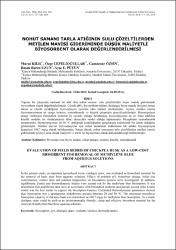| dc.contributor.author | Kılıç, Murat | |
| dc.contributor.author | Çepelioğullar, Özge | |
| dc.contributor.author | Özsin, Gamzenur | |
| dc.contributor.author | Uzun, Başak Burcu | |
| dc.contributor.author | Pütün, Ayşe Eren | |
| dc.date.accessioned | 2019-10-21T21:12:18Z | |
| dc.date.available | 2019-10-21T21:12:18Z | |
| dc.date.issued | 2014 | |
| dc.identifier.issn | 1300-1884 | |
| dc.identifier.uri | http://www.trdizin.gov.tr/publication/paper/detail/TVRnNU1ESXpNdz09 | |
| dc.identifier.uri | https://hdl.handle.net/11421/21335 | |
| dc.description.abstract | Yapılan bu çalışmada tarımsal bir atık olan nohut samanı, sulu çözeltilerden boyar madde gideriminde biyosorbent olarak değerlendirilmiştir. Çözelti pH'ı, biyosorbent miktarı, başlangıç boyar madde derişimi, temas süresi ve çözelti sıcaklığının biyosorpsiyon işlemine olan etkileri incelenmiştir. Ayrıca, metilen mavisi biyosorpsiyonuna ait denge izoterm, termodinamik ve kinetik çalışmalar gerçekleştirilmiştir. Biyosorpsiyon denge verilerinin Freundlich izotermi ile uyumlu olduğu belirlenmiş, biyosorpsiyonu en iyi ifade edebilen kinetik modelin ise sözde(yalancı) ikinci dereceden model olduğu saptanmıştır. Hesaplanan termodinamik parametreler, biyosorpsiyonun 20-50 °C aralığında kendiliğinden gerçekleşen endotermik bir işlem olduğunu göstermiştir. Metilen mavisi biyosorpsiyonu için nohut samanının maksimum tek tabaka biyosorpsiyon kapasitesi 108,7 mg/g olarak belirlenmiştir. Sonuç olarak, nohut samanının sulu çözeltilerden metilen mavisi gideriminde çevreye dost, düşük maliyetli ve etkili bir biyosorbent olarak kullanılabileceği belirlenmiştir. | en_US |
| dc.description.abstract | In the present study, an important agricultural waste, chickpea straw, was evaluated as biosorbent material for the removal of basic dyes from aqueous solutions. Effects of solution pH, biosorbent dosage, initial dye concentration, contact time and solution temperature on biosorption process were investigated. In addition, equilibrium, kinetic and thermodynamic studies were carried out for the methylene blue biosorption. It was determined that equilibrium data were in accordance with Freundlich isotherm and pseudo second order kinetic model was the best model to express the biosorption kinetics. Calculated thermodynamic parameters showed that, biosorption was a spontaneous endothermic process between 20 and 50 °C. The maximum monolayer biosorption capacity of chickpea husk was determined as 108.7 mg/g for methylene blue biosorption. As a result, chickpea straw could be used as an environmentally friendly, cheap and effective biosorbent material for the removal of methylene blue from aqueous solutions. | en_US |
| dc.language.iso | tur | en_US |
| dc.rights | info:eu-repo/semantics/openAccess | en_US |
| dc.subject | Mühendislik | en_US |
| dc.subject | Ortak Disiplinler | en_US |
| dc.title | Nohut Samanı Tarla Atığının Sulu Çözeltilerden Metilen Mavisi Gideriminde Düşük Maliyetli Biyosorbent Olarak Değerlendirilmesi | en_US |
| dc.title.alternative | Evaluation of Field Debris of Chickpea Husk as a Low-Cost Biosorbent for Removal of Methylene Blue from Aqueous Solutions | en_US |
| dc.type | article | en_US |
| dc.relation.journal | Gazi Üniversitesi Mühendislik Mimarlık Fakültesi Dergisi | en_US |
| dc.contributor.department | Anadolu Üniversitesi, Mühendislik Fakültesi, Kimya Mühendisliği Bölümü | en_US |
| dc.identifier.volume | 29 | en_US |
| dc.identifier.issue | 4 | en_US |
| dc.identifier.startpage | 717 | en_US |
| dc.identifier.endpage | 724 | en_US |
| dc.relation.publicationcategory | Makale - Ulusal Hakemli Dergi - Kurum Öğretim Elemanı | en_US |


















